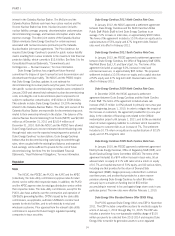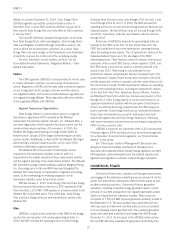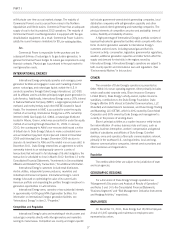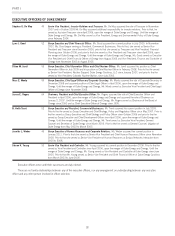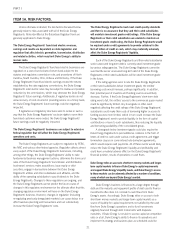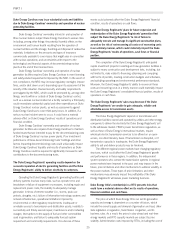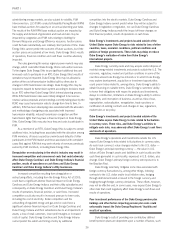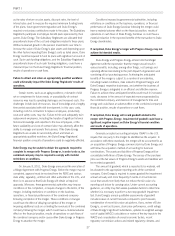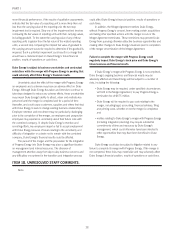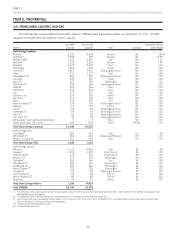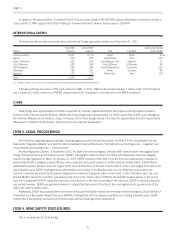Duke Energy 2011 Annual Report Download - page 41
Download and view the complete annual report
Please find page 41 of the 2011 Duke Energy annual report below. You can navigate through the pages in the report by either clicking on the pages listed below, or by using the keyword search tool below to find specific information within the annual report.
PART I
ITEM 1A. RISK FACTORS.
Unless otherwise indicated, the risk factors discussed below
generally relate to risks associated with all of the Duke Energy
Registrants. Risks identified at the Subsidiary Registrant level are
generally applicable to Duke Energy.
The Duke Energy Registrants’ franchised electric revenues,
earnings and results are dependent on state legislation and
regulation that affect electric generation, transmission, distribution
and related activities, which may limit Duke Energy’s ability to
recover costs.
The Duke Energy Registrants’ franchised electric businesses are
regulated on a cost-of-service/rate-of-return basis subject to the
statutes and regulatory commission rules and procedures of North
Carolina, South Carolina, Ohio, Indiana and Kentucky. If the Duke
Energy Registrants’ franchised electric earnings exceed the returns
established by the state regulatory commissions, the Duke Energy
Registrants’ retail electric rates may be subject to review and possible
reduction by the commissions, which may decrease the Duke Energy
Registrants’ future earnings. Additionally, if regulatory bodies do not
allow recovery of costs incurred in providing service on a timely basis,
the Duke Energy Registrants’ future earnings could be negatively
impacted.
If legislative and regulatory structures were to evolve in such a
way that the Duke Energy Registrants’ exclusive rights to serve their
franchised customers were eroded, the Duke Energy Registrants’
future earnings could be negatively impacted.
The Duke Energy Registrants’ businesses are subject to extensive
federal regulation that will affect the Duke Energy Registrants’
operations and costs.
The Duke Energy Registrants are subject to regulation by FERC,
the NRC and various other federal agencies. Regulation affects almost
every aspect of the Duke Energy Registrants’ businesses, including,
among other things, the Duke Energy Registrants’ ability to: take
fundamental business management actions; determine the terms and
rates of the Duke Energy Registrants’ transmission and distribution
businesses’ services; make acquisitions; issue equity or debt
securities; engage in transactions between the Duke Energy
Registrants’ utilities and other subsidiaries and affiliates; and the
ability of the operating subsidiaries to pay dividends to the Duke
Energy Registrants. Changes to these regulations are ongoing, and
the Duke Energy Registrants cannot predict the future course of
changes in this regulatory environment or the ultimate effect that this
changing regulatory environment will have on the Duke Energy
Registrants’ business. However, changes in regulation (including
re-regulating previously deregulated markets) can cause delays in or
affect business planning and transactions and can substantially
increase the Duke Energy Registrants’ costs.
TheDukeEnergyRegistrantsmustmeet credit quality standards
and there is no assurance that they and their rated subsidiaries
will maintain investment grade credit ratings. If the Duke Energy
Registrants or their rated subsidiaries are unable to maintain an
investment grade credit rating, the Duke Energy Registrants would
be required under credit agreements to provide collateral in the
form of letters of credit or cash, which may materially adversely
affect the Duke Energy Registrants’ liquidity.
Each of the Duke Energy Registrants and their rated subsidiaries
senior unsecured long-term debt is currently rated investment grade
by various rating agencies. The Duke Energy Registrants cannot be
sure that the senior unsecured long-term debt of the Duke Energy
Registrants or their rated subsidiaries will be rated investment grade
in the future.
If the rating agencies were to rate the Duke Energy Registrants
or their rated subsidiaries below investment grade, the entities’
borrowing costs would increase, perhaps significantly. In addition,
their potential pool of investors and funding sources would likely
decrease. Further, if the Duke Energy Registrants’ short-term debt
rating were to fall, the entities’ access to the commercial paper market
could be significantly limited. Any downgrade or other event
negatively affecting the credit ratings of the Duke Energy Registrants’
subsidiaries could make their costs of borrowing higher or access to
funding sources more limited, which in turn could increase the Duke
Energy Registrants’ need to provide liquidity in the form of capital
contributions or loans to such subsidiaries, thus reducing the liquidity
and borrowing availability of the consolidated group.
A downgrade below investment grade could also require the
Duke Energy Registrants to post additional collateral in the form of
letters of credit or cash under various credit agreements and trigger
termination clauses in some interest rate derivative agreements,
which would require cash payments. All of these events would likely
reduce the Duke Energy Registrants’ liquidity and profitability and
could have a material adverse effect on the Duke Energy Registrants’
financial position, results of operations or cash flows.
Duke Energy relies on access to short-term money markets and longer-
term capital markets to finance Duke Energy’s capital requirements
and support Duke Energy’s liquidity needs, and Duke Energy’s access
to those markets can be adversely affected by a number of conditions,
many of which are beyond Duke Energy’s control.
Duke Energy’s business is financed to a large degree through
debt and the maturity and repayment profile of debt used to finance
investments often does not correlate to cash flows from Duke
Energy’s assets. Accordingly, Duke Energy relies on access to both
short-term money markets and longer-term capital markets as a
source of liquidity for capital requirements not satisfied by the cash
flow from Duke Energy’s operations and to fund investments
originally financed through debt instruments with disparate
maturities. If Duke Energy is not able to access capital at competitive
rates or at all, Duke Energy’s ability to finance its operations and
implement its strategy and business plan as scheduled could be
21





